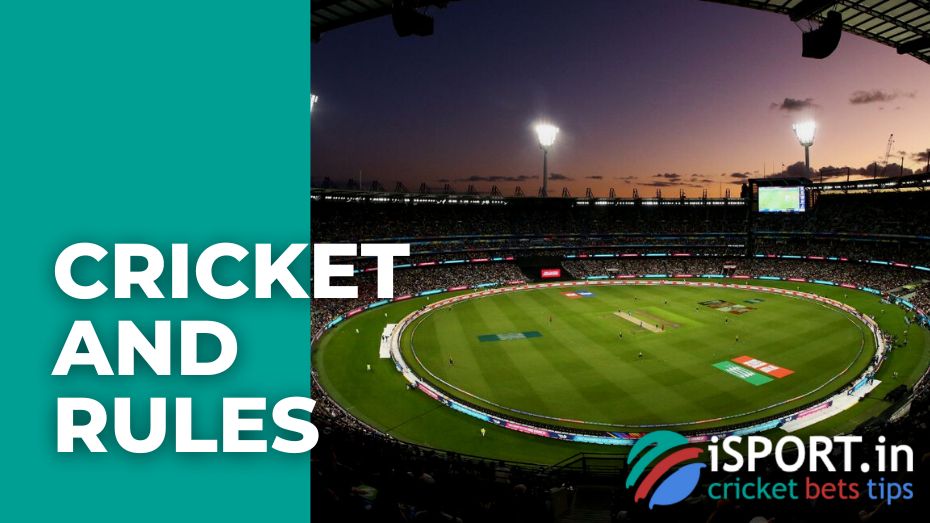Cricket
Cricket is one of the most interesting team games. Cricket is very popular in South Asia (especially India), South Africa, the West Indies, as well as in Australia and the UK, where it originated. We will analyze in detail the cricket vocabulary, the structure of world cricket, the rules and types of the game, and much more.
We disassemble cricket - the most popular old game with a bat and a ball

Cricket was once originally an English sport, but now it is played worldwide. Regional championships are held in India, Australia, Pakistan, the West Indies and other countries. In terms of popularity worldwide, the game of cricket may well compete, if not with football, then with hockey or basketball for sure. We talk about cricket, the rules and features of this game, the formats of matches, and the history of cricket.
A brief history of cricket
This game originated in the 13th century in England. At first, only children and young peasants played it, but then both adults and aristocrats gradually began to play, and cricket became an integral part of the country’s traditions.
The first cricket club was established in Hampshire in the 18th century, and the first set of rules of the game was officially recorded. A little later, a cricket ground was created in London, and then the Marylebone Cricket Club (MCC) was opened, which became the most powerful club in England.
Speaking about cricket and its history at the international level, one cannot fail to mention that this game gained fame due to the growing influence of the British Empire.
In 1900, cricket was even included in the Olympic Games. But, alas, the game did not gain wide popularity, the competition was also too low, Great Britain and France played between themselves, the victory went, of course, to the British. At the moment, cricket is not an Olympic sport.

About cricket and its rules
Cricket is a game steeped in history and tradition. Therefore, its rules are quite confusing and sometimes, to understand all the nuances, a year will not be enough, which will be spent watching world-class championships. It is not uncommon for heated debates to unfold around one or another judicial decision, and it even reached the point of assault a century ago. However, the basic rules of cricket, which will allow everyone to enjoy watching matches and understand what is happening on the field, are quite simple. Let’s talk about them in order:
- The cricket field is oval with a small arena called “pitch” in the center, which is always the same size: 22 yards (20.12 meters) by 10 feet (3.04 meters). There are wickets on opposite sides of the pitch – this is the name of three vertical wooden columns dug into the ground, from above wooden lintels, bails unite them.
- Cricket is played with a ball and bat.
- Two teams are opposed to each other in a match, including 11 players.
- In turn, the opposing teams take the moves, which are called innings in cricket. There are two types of moves in cricket: batting and bowling.
Accordingly, the players have two main roles: the batsman (the one who hits the ball with the bat, defending his team’s wicket) and the bowler (the one who serves the ball, attacking the opponent’s wicket).
- All players are on the field, from the defending team – only two from the team that attacks. Bowlers throw the ball trying to break the opponent’s wicket (make the bails fall).
- Each team, depending on the format of the match, has one or two innings.
- The team’s goal during the match is to earn as many wounds as possible – the so-called cricket points.
- Bowler, trying to break the opponent’s wicket, throws the ball six times (this is called an “over”). Then he is replaced by another player of his team.
- The batsman who hits the ball with a bat can be either defensive or offensive. The purpose of the defensive blow is to protect the wicket, and the attacking blow also provides an opportunity to earn wounds. If the batsman performs an attack hit, he and the second batsman, who is simultaneously on the field at the second wicket, run towards each other to change places and touch the ground with any part of the body or with a bat. The team receives one run for each such run-up (their team receives two runs for a successful run of both batsmen). Sometimes, if the attacking batsman’s punch was good, he and the second batsman can make a few dashes. The time for this ends when opposing players take possession of the ball again and are ready to kick. In this case, the batsman’s team will receive 4 points if the ball rolls out of the field and six – if it goes out of the field.
- The task of the attacking team members, who are dispersed across the field, is to prevent the batsman from hitting the ball for a long distance, thereby reducing his chances of earning points. During the match, they try to catch the batsman’s bounced ball before it touches the ground (this will disqualify the batsman), and after the batsman has hit the ball, return it to the game to reduce the number of runs as soon as possible.
- Swap positions of the attacking and defending teams after the number of overs have been exhausted or when all defenders are dismissed.
- Breaking the wicket is one of the ways to fire a batsman who could not reflect the blow. Also, the batsman leaves the field if he hits the ball directly into the opponent’s hands, while the ball does not touch the ground. And the batsman is fired if, during the run, the opponent managed to pick up the ball and destroyed the wicket.
- The team with the most points wins.
- Bowlers’ rating is calculated based on the number of wickets they have destroyed. The performance of batsmen is counted in hundreds of runs (centuries), recruited without dismissal. The rating of the players, world or regional, is built on these indicators.
Even though there is no strict distribution of roles in cricket, players can act as both bowlers and batsmen, as a rule, they have specializations: those who are good at attack rarely master the bat, and vice versa.
Speaking about cricket and its rules, it is also worth mentioning that cricket may look like a harmless sport at times. This appearance is very deceiving. A professional bowler can throw a ball at a speed of about 150 km / h, and a world-class batsman can hit it so that the ball travels a hundred meters. So this sport can be very dangerous. Players need protective equipment not for beauty.

Cricket formats
The peculiarity of cricket is that one match can last not only one day but several days.
There are several formats of cricket in the world. They differ in duration and some nuances of the rules.
- Test cricket. It is a traditional cricket format that has been played officially since 1877. Matches in this format last 5 days. Cricketers play for 6 hours with breaks for a 40-minute lunch and two 20-minute teas. Teams play two innings every day. As a rule, test matches are combined in a series of 5 games, and one such series lasts about a month and a half. Test cricket is the most difficult format and a real challenge for players. This is the oldest and most traditional format, and the rest are in some way derived from it. The essence of derivative cricket formats is to make matches more dynamic, convenient to broadcast on television, and thus attract new fans and retain old ones.
- One Day Internationals (ODI). This format appeared in 1971 but gained popularity only in 1980. This match consists of one inning, and each side has 50 overs. Teams excel in this format, which can combine excellent technique and speed. This game format was invented for the World Championships and has become especially popular in recent years. It is in this format that, for example, the ICC Champions Trophy is held, where the 8 best teams in the world participate, the ICC Women’s Cricket World Cup (held every four years) and the ICC U19 Cricket World Cup (held every two years).
- Twenty20. This game format is the most widespread in the world. Speaking of cricket in the Twenty20 format, it is worth saying that this format is new compared to the two above. In a Twenty20 Internationals match, each team has 20 overs. This format was introduced in 2005. The match lasts about 3 hours.
- The Hundred. This is the shortest format for a cricket match and is limited to one hundred tosses per team. The game lasts about the same as a football match.
Three match formats are played internationally: the Test cricket, the One Day Internationals, the Twenty20 Internationals. They are conducted according to the rules established by the ICC.

International and regional cricket
Speaking of cricket internationally, it is worth mentioning that all matches are held under the auspices of the ICC – International Cricket Council.
At the moment, a large number of international championships are being held, and there are several main ones:
- ICC World Test Championship (Test Cricket). It has been held since 2019.
- ICC Men’s Champions Trophy (ODI Cricket). It has been held since 1998.
- ICC Men’s World Twenty20 (T20I Cricket). It has been held since 2007.
- ICC Men’s T20 World Cup (T20I Cricket). It has been held since 2007.
- ICC Men’s Cricket World Cup (ODI Cricket). It has been held since 1975.
- ICC Men’s Cricket World Cup Super League (ODI Cricket). It has been held since 2019.
- ICC Men’s Cricket World Cup Super Challenge League (List A format). It has been held since 2019.
- ICC Men’s Cricket World Cup Super League 2 (ODI Cricket). It has been held since 2019.
- ICC U19 Cricket World Cup. It has been held since 1988.
- ICC Women’s T20 World Cup (T20I Cricket). It has been held since 2009.
- ICC Women’s Championship. It has been held since 2014 and is a qualifying tournament for participation in the ICC Women’s Cricket World Cup.
- ICC Women’s Cricket World Cup (ODI Cricket). It has been held since 1973.
- ICC Women’s Under-19 T20 World Cup (T20I Cricket).It is planned to be held from 2023.
The ICC has 104 members, 16 from America, 34 from Europe, 21 from Asia, 11 from East Asia Pacific, 22 from Africa. Teams of all participants have T20I Status, 12 ICC participants have Test Match status, which means they can also participate in the ODI and T20I championships. In total, 16 ICC members have ODI status.
Regional championships are also held in each of the countries participating in the ICC. The most popular cricket in England and the countries of the former British Empire, such as India, Afghanistan, Australia, Bangladesh, Ireland, New Zealand, Zimbabwe, Kenya and others.
